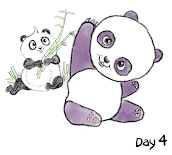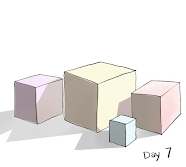Art's Axiom
- If you want to learn to draw, draw every day.
This week's drawings
This week we'll learn the cylinder, use the cylinder to draw tubes, continue using the cube to draw more complex structures, and draw manga:
Materials:
- graphite pencil
- charcoal pencil
- eraser
- paper (printer paper, notebook, etc)
- colors (colored pencils, crayons, watercolor, etc)
- alternatives to the above: smart phone or tablet drawing app
Day 16: the cylinder
I added Hello Kitty to my cylinders to make them more fun. Here is a How to Draw Hello Kitty by Art For Kids Hub (an 8 minute video with 11 million views. Use shift-N to get past the advertisements)
Day 17: advanced-level cylinders
In Lesson 11 Mark guides you in drawing a cityscape of cylinders. He begins by bringing your attention to using size and overlap as methods to create three dimensional objects in 'space'. He then goes into a step by step tutorial for drawing. Lesson 11 starts on page 105 of his book.
I decided to do Lesson 11's bonus challenge: holes - cylinders going down versus cylinders going up. A hole is a good place for a meerkat to hide in. Here is HTDraw's How to Draw a Meerkat Easy Step by Step (4 minutes, 2.3K views).
Here is a link to mark's video for this lesson: You Can Draw in 30 Days: Day 11
Day 18: constructing with cubes
Here is a link to Lesson 12, Constructing with Cubes in Mark Kistler's You can draw in 30 days : the fun, easy way to learn to draw in one month or less. He uses cubes to build a house with a pitched roof. He also gives us a peek at using two point perspective to create the illusion of space. Finally, he uses cubes to 'carve out' the interior space of the house.
Here is the link to Mark's video of this lesson: You Can Draw in 30 Days: Day 12
Day 19: chibi proportion
In their book You Can Draw Manga Chibi Characters, Critters & Scenes: A step-by-step guide for learning to draw cute and colorful manga chibis and critters, Samatha Whitten and Jeannie Lee provide instructions for creating chibi characters. They begin with the head and neck; give examples of drawing the eyes, and hair; and draw a chibi experiencing various emotions. They give you manikins for chibi kid bodies and adult bodies and example drawings of clothing (shirts, pants, shorts, shoes, purses).
I've done sketches of the manikins. I think of them as bulky stick-figures. Note that the 'adult' chibi's head is proportionally smaller than the 'kid' chibi's head. I encourage you to think about these as guides; tricks to help you create three dimensional drawings of the characters that live in your imagnination.
Here are three YouTube videos for your consideration:
- How to Draw a Chibi by UsaChanArt (a 14 minute video with 1.9 million views)
- Mapping a Cute Easy Anime Face by mickeymegamega (a 46 minute video with 1.3 million views)
- How to Draw Manga Eyes! Step by Step, Slow Tutorial for Beginners! by Love2DrawManga (a 16 minute video with 1.3 million views)
Day 20: manga faces
In his book, Mastering Manga, How To Draw Manga Faces, Mark Crilley gives you step-by-step instructions for drawing: - Female Front View
- Female Three-Quarter View
- Male Front View
- Male Profile View
- 20 Female Hairstyles
- 20 Male Hairstyles
- Adult Front View
- Adult Three-Quarter View
- Fuller-Figured Character Front View
- Fuller-Figured Character Three-Quarter View
- Child Front View
- Child Profile View
Since this book is readily available (i.e., you don't have to borrow it), I've provided links to each tutorial.
Here are some manga face and hair videos that you may like:How to Draw Manga Girl Face in Front, 3/4, and Side View by Love2DrawManga ( 11 minutes, 165K views)How to Draw Hair | ANY HAIRSTYLES Tutorial with 10 Art Tips by Whyt Manga (20 minutes, 1.2M views)How to draw anime hair | Step by step easy! by miikobelle (8 minutes, 31 K)
- Female Front View
- Female Three-Quarter View
- Male Front View
- Male Profile View
- 20 Female Hairstyles
- 20 Male Hairstyles
- Adult Front View
- Adult Three-Quarter View
- Fuller-Figured Character Front View
- Fuller-Figured Character Three-Quarter View
- Child Front View
- Child Profile View
Day 21: manga eyes
- leave space at the corners
- horizontal oval for basic eye shape
- the iris and pupil normally continue above upper eyelid
- drawing highlights, larger one can overlap the iris
- sketch your drawing in pencil, then ink in your drawing
After sketching with a graphite pencil (HB), I darkened my lines with a charcoal pencil (PRANG 601-M) and then inked in the right eye. Charcoal pencils make nice, dark lines
For a video tutorial see How to Draw Manga Eyes! Step by Step, Slow Tutorial for Beginners! by Love2DrawManga (a 16 minute video with 1.3 million views)
Day 22: manga hair
The Anime Art Magazine article Drawing hair: all you need to know to get started! provides ideas to keep in mind while drawing hair on our characters: hair origin; three hair "sections"; hair bundling; and relation between hair style and length to character.
WikiHow gives us tutorials for 6 Ways to Draw Anime Hair.
Selene Filisi shows us How To Draw Anime Hair for Boys and Men.
In his book, Mastering Manga, How To Draw Manga Faces, Mark Crilley has examples of manga hairstyles:
Here are three video tutorials on for drawing manga hair:
- How to Draw Hair | ANY HAIRSTYLES Tutorial with 10 Art Tips by Whyt Manga (20 minutes, 1.2M views)
- How to draw anime hair | Step by step easy! by miikobelle (8 minutes, 31 K)
- PROCREATE| How To Color Anime Hair For Beginners [Simple & Easy] by Dicentra Asterisk (7 minutes, 67K views)



























